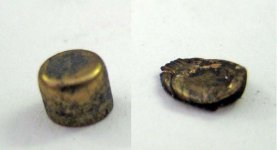From your original post I could not determine if you had a rifle, shotgun or revolver. Then I noticed, "all I do is to keep firing untill that cap comes round again"
Okay, that tells me it's a revolver.
Anytime the caps give me trouble on my Colt-pattern revolver, I look for a fragment of flattened cap in the frame's hammer channel, under the hammer.
This prevents the hammer from fully reaching the cap, or at least striking it with full force.
This may be your problem.
Or, as others noted, you may not have fully seated the cap.
Cap fragments in the hammer channel may be down low, difficult to see because they're covered with fouling.
A small screwdriver run down the channel will dislodge them, but it's best to do this with the revolver upside down so any fragments fall free.
As for caps being set off by thumb pressure: The late gun writer Elmer Keith wrote in his 1955 classic book, Sixguns:
"One should select a cap size that is a snug push fit on the nipples, but not tight enough to prevent their seating fully down on the nipple. A couple times I have had muzzle loading rifles fire when I pressed the cap down too hard on the nipple. The caps were a bit small and I forced them down, splitting them. Each time they fired from the pressure with the ball of my thumb, they raised instantly a healthy blister."
Now, I'll jump the gun here and make a couple of points before others scramble over their keyboards:
1. Keith was known to embellish. I knew a woman years ago whose husband was an Idaho Fish & Game officer in the Salmon, Idaho area where Keith lived. He knew Keith well and unsuccessfully tried a number of times to apprehend him for poaching game.
She was not a fan of Keith, considering him to be a big windbag that walked around town with two .44 revolvers on his hip everywhere he went. The locals snickered at him, she said, for his posturing and exaggeration.
For me, who had long been a Keith admirer, it was quite a revelation. Yet, I knew this woman well and believe her.
So, perhaps what Keith wrote above is untrue or embellished.
Or ...
Keith likely used caps made with fulminate of mercury, which is reportedly more sensitive than today's modern percussion caps.
I'm not sure what substance is used in today's percussion caps, probably something identical or akin to modern primers. Whatever it is, modern percussion caps no longer contain mercury and haven't since probably the 1940s, or even earlier.
It is difficult to diagnose what your revolver problem is, but I'd guess that either cap fragments in the hammer channel, caps too small for the nipples or caps that haven't been seated.
There is also the possibility that the nipples are a tad too short and the hammer doesn't fully reach the cap.
If any one of us were there, we could probably spot the bugaboo in a minute.
I hope you find the cause.

